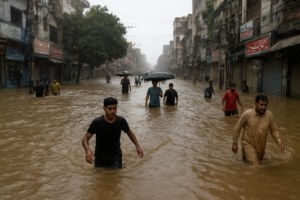
1. What’s Happening?
Pakistan is grappling with severe flood outbreaks following intense cloudbursts and weak urban drainage systems. Recent satellite and street-level images reveal submerged neighborhoods and choked drainage networks, especially in Karachi and northwestern regions. Since mid-August, over 776 lives have been lost, with around 197 children among the victims.
2. Scope of Disaster
Heavy localized rainfalls from sudden cloudbursts—particularly in mountainous zones—have triggered flash floods and landslides, causing devastating human and infrastructural damage. Cities like Karachi, with outdated drainage capacity (40 mm max), have seen streets transform into rivers, paralyzing daily life
3. Rescue Efforts & Strain on Infrastructure
Over 25,000 people have been rescued by military and NDMA teams, with specialized personnel operating amidst submerged and hazardous conditions. Temporary medical camps and relief operations are underway, but recurrent rainfall continues to stretch already fragile systems
4. Underlying Causes
Climate change plays a central role, ramping up intensity of rainfalls, while urban sprawl, deforestation, and poor infrastructure underpin the disaster’s scale. Melting glaciers and increased atmospheric moisture exacerbate flash flood risks—foreshadowing further emergencies if adaptive resilience isn’t addressed
5. Call for Action
Experts encourage overhauling urban infrastructure, investing in modern early-warning systems, and enforcing better environmental practices. Proactive measures are essential to manage future monsoon threats and protect vulnerable populations.